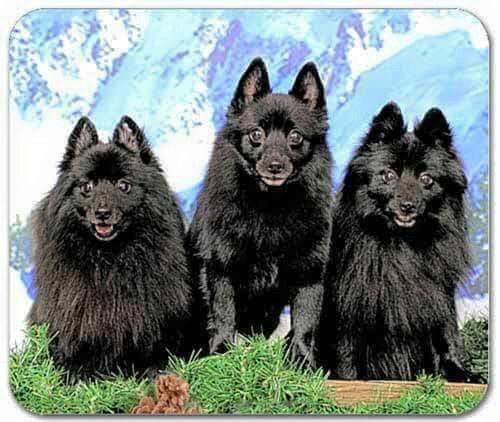
There is such a thing as a “fluff” Schipperke, a longer coated Schipp that’s the result of a double recessive gene (meaning a pup must inherit a “fluff” gene from each parent in order to be a fluff). The gene responsible was previously identified in Chihuahuas, Dalmatians, Shiba Inus, Labrador Retrievers, Mastiffs, German Shepherd Dogs, Alaskan Malamutes, Cardigan Welsh Corgis, Rottweilers, Dachshunds, Weimaraners and Norwich Terriers, and has now been seen to also apply to Schipperke “fluffs.” With the help of breeders (because that’s what good breeders do), a DNA test was developed by Drs. Donna Housley and Patrick Venta using donated research samples, and tested by DNA Diagnostics Center, the world’s largest private DNA testing laboratory.
In all of the aforementioned breeds, long-haired coat length is inherited as an autosomal recessive trait from carriers who appear normal coated, but the offspring produced by them has a 50% chance of being a carrier, as well. This next bit we got from the Schipperke Club of America as written by Shirley Quillen: “The genotypes possible are Normal/Normal, (N/N) those individuals having two copies of the normal short-haired allele; Normal/Affected (N/F), those individuals which are carriers but appear Normal; and Affected/Affected (F/F), those individuals with two alleles for long-haired mutation which are long-haired. The genetic test developed identifies coat length genotypes allowing breeders to be more selective in mating so as not to produce long-haired individuals.”
A while back, Marlene Ezell shared this photograph of her litter of three little ladies. Two of them turned out to be fluffs, and they are on the outside.

We have a Schipperke that has not lost it’s coat and this is the first I have read of this. He is 10 months old and is our second Schip. I have seen his parents and they had short hair.
Your Schip is lovely, Fern! We don’t think the article suggested that a dog will lose its coat, it has more to do with the “fluff” gene….
I am still curious on the grooming if anyone has suggestions. I brush daily, however the undercoat is still getting matted. I don’t think a rake will be helpful – and I have tried. The vet did cut back the fur in the rear end and that did grow back without any issues.
Fern, we posed your question to our 84,000+ readers on Facebook, and so far, here are the different replies:
Jennifer writes: Master Groomer expertise here: even the Fluff Schipperke should not be shaved off, especially on the upper torso, when the undercoat gets matted. Here is an article I published in my national grooming column that gives steps to de-mat by pre-soaking in conditioner and using a high velocity dryer. Shaving around privates area is all undercoat hairs and should not cause major skin problems. PM me for details on the critical information on “Fur vs Hair” type coats in dogs. Here’s that link::
https://www.groomertogroomer.com/painless-de-matting…/
Peggy writes: that the schipperke occasionally has long coat is no surprise. and you would groom them the same as a pomeranian. She offers an image seen at this link: https://www.facebook.com/photo.php?fbid=10229933048046006&set=p.10229933048046006&type=3
And finally, we encourage you to keep checking the thread as readers add their opinions. You can see it under the Schipperke image on our FB page posted on August 7, 2023.
we have a 10 year old fluff. he is also quite large, 25 pounds. we were told not to bathe him as it interfered with the double coat. He now has seasonal allergies and we are wondering if we should start bathing him. He doesn’t mind getting wet up to his feet….but beyond that, it’s a LOT of hair and fur to dry.
Also, he does not blow his coat. We try to brush him and can thin it out that way. Any suggestions? Is our advice completely bogus?
Ollie, our 10 year old fluff.
Your dog looks so much like our Schipperke. I do bathe him, but unlike our previous Schip he does not she’d. I can brush for hours and remove quite a large amount of fur and still it doesn’t thin out. He also has his tail which is like a big puff. He gets very hot and it’s tough to see. We were also told not to cut the fur.
We have a fluff….and she is wonderful! Also a bit of a runt, but a joyous, fun loving sweetheart. Here is my question: How do you groom one of these?!?!?! In the summer she gets so hot…even in winter she sleeps on a tile floor to keep cool. A groomer said if cut short, it will destroy their “over/upper” coat and it shouldn’t be cut short….rather “rake out” the undercoat…….which is unbelievably thick….. She also has long flowing (almost mane like) fur/hair on her legs (which of course get full of mud, weeds, etc.
We want to cut her short, but we were warned if we did that, it is disastrous and will never grow back. Is there some kind of grooming guide for fluffs we can share with another groomer who has schipperke experience, but has never trimmed/groomed a fluff
Do not cut you will make them hotter and exposure will be directly to UV. With their coat intact and dead undercoat brushed out cool air is brought to the skin. You will damage and break the coat and change the texture if you shave/clip it down
I have a fluff. We lived in Darwin, NT, I got him cut, it grew back fine. I have had him cut several times since and it always grows back long, shiny and fluffy. We are in NSW now, it is much colder than the NT and I still get him cut and he is fine.
Get a good “rake” and enjoy the bonding time as you clean out the undercoat. Your Schip will love you for it and you can stuff pillows as a side hobby!
Our fluff Fozzie.